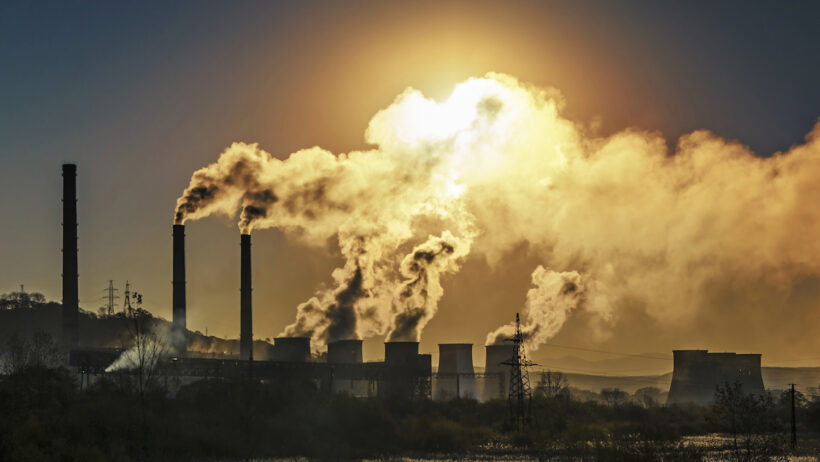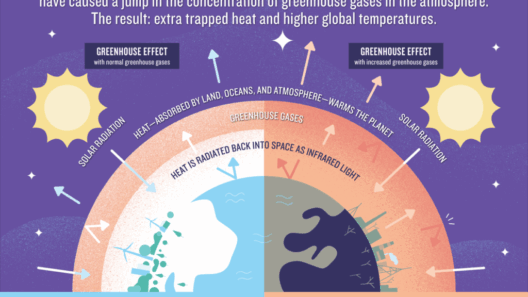The greenhouse effect is a fundamental concept in understanding climate dynamics, influencing the temperature of our planet in profound ways. It evokes fascination due to the delicate interplay between various atmospheric gases and their significant impact on global temperatures. In this exploration, we demystify the mechanisms through which greenhouse gases contribute to this essential, yet potentially perilous phenomenon.
To comprehend the greenhouse effect, one must first grasp the fundamental nature of Earth’s atmosphere. A multitude of gases envelops the planet, including nitrogen, oxygen, carbon dioxide (CO2), methane (CH4), and nitrous oxide (N2O), among others. While most of these gases are relatively benign, certain trace gases have a potent capability to trap heat. This characteristic is central to their role in augmenting the greenhouse effect.
Solar radiation enters the Earth’s atmosphere, where a portion is absorbed by the surface, warming the planet. This heat is then re-emitted as infrared radiation. Greenhouse gases intercept some of this outgoing radiation, effectively re-radiating it back toward the surface. This warming mechanism is similar to the function of a blanket, which retains heat. Thus, while the greenhouse effect is a natural occurrence, human activities have amplified it, leading to climatic perturbations.
The juxtaposition of natural and anthropogenic contributions underscores the urgency of understanding greenhouse gases. Their increasing concentrations in the atmosphere signal alarming trends. The quest to decipher the complexities of greenhouse gas emissions reveals not only their sources but also implications for planetary health.
Sources of Greenhouse Gases: What Fuels the Increase?
A prevailing observation in modern society is the escalation of greenhouse gas levels, attributed largely to industrialization and agricultural practices. The overwhelming reliance on fossil fuels—coal, oil, and natural gas—accounts for a staggering percentage of global carbon dioxide emissions. These fuels release CO2 upon combustion, significantly elevating its concentration in our atmosphere.
However, CO2 is not the sole contributor to the greenhouse phenomenon. Methane, predominantly produced by enteric fermentation in livestock and rice cultivation, poses a considerable challenge. Despite its shorter atmospheric lifespan compared to CO2, methane is approximately 25 times more potent as a greenhouse gas over a century. This point highlights the importance of addressing agricultural practices alongside fossil fuel consumption.
Adding further complexity are industrial processes that emit nitrous oxide and hydrofluorocarbons. The former is often released during fertilizer application and agricultural activities, while the latter stems from refrigeration and air conditioning systems. Together, these gases create a multifaceted tapestry of greenhouse gas emissions, accelerating global warming. Understanding these intricacies is paramount for developing effective mitigation strategies.
The Science of Absorption: How Gases Hold Heat
Delving deeper into the mechanics of the greenhouse effect, one learns about the unique properties of greenhouse gases. Each gas has distinct molecular structures, allowing them to absorb and emit infrared radiation at specific wavelengths. This selective absorption is what gives gases their warming capability.
Carbon dioxide, for instance, has a long atmospheric lifetime and absorbs energy over a range of wavelengths. Its omnipresence greatly influences the overall greenhouse effect. Conversely, methane, with its ability to absorb energy in the shortwave spectrum, excels in trapping heat more effectively than CO2, despite its lower atmospheric concentration.
This differential impact of gases is not merely academic; it has profound implications for climate policy. Understanding the potency of gases like methane may lead to targeted initiatives aimed at curbing emissions from agriculture and waste management. Moreover, scientific advancements in satellite technology and climate modeling have augmented our ability to monitor these gases more precisely, enhancing predictive capabilities.
Feedback Loops: The Compounding Effect of Temperature Increases
A critical aspect often overlooked in discussions about greenhouse gases is the concept of feedback loops. As temperatures rise, several natural processes can exacerbate the greenhouse effect, creating a self-perpetuating cycle. For instance, thawing permafrost releases significant amounts of methane, previously trapped as frozen organic matter. This release further intensifies warming, illustrating how interconnected Earth’s systems are.
The implications of feedback loops extend beyond mere temperature increases; they may alter weather patterns, leading to extreme events such as droughts and severe storms. Such changes can impact agriculture, biodiversity, and fresh water availability, emphasizing the urgent need for comprehensive strategies to address greenhouse gas emissions holistically.
Mitigation Strategies: Addressing the Emissions
To combat the pervasive influence of greenhouse gases, it is essential to enact robust mitigation strategies. Transitioning from fossil fuels to renewable energy sources, such as solar, wind, and hydroelectric power, represents one of the most effective approaches. Additionally, widespread adoption of energy efficiency practices and technological innovations in transportation can yield significant reductions in CO2 emissions.
Furthermore, reforestation and afforestation initiatives play a pivotal role in sequestering carbon. Forests act as natural carbon sinks, absorbing CO2 from the atmosphere and mitigating greenhouse effects. Moreover, sustainable agricultural practices, including reduced tillage and crop rotation, can lessen emissions of methane and nitrous oxide.
In addition to technological advancements, public awareness and advocacy are crucial. Fostering a culture of sustainability through education and community engagement can empower individuals to make informed choices. Informed consumers create demand for greener products, compelling businesses to adopt more sustainable practices.
Conclusion: A Collective Responsibility
The profound effects of greenhouse gases on our planet illuminate the critical interconnections within our climate system. Understanding their contribution to the greenhouse effect not only informs advocacy efforts but also underscores the collective responsibility we bear as stewards of the Earth. By fostering awareness and embracing sustainable practices, we can forge a path toward a more balanced and resilient future, where humanity coexists harmoniously with its environment.







